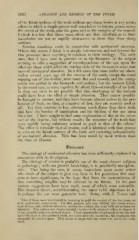Page 992 - My FlipBook
P. 992
1002 ABRASION AND EROSION OF THE TEETH.
of the labial surfaces of the teeth without any sharp incuts at any point;
others in which a simple groove well rounded at its bottom occurs across
the crown of the teeth, near the gum, and at the margins of the enamel.
I think it a fact that those cases which are thus indefinite as to their
boundaries are not as rapidly destructive as those that show sharp
outlines.
Erosion sometimes exists in association with mechanical abrasion.
Where this occurs I think it is simply intercurrent, and not because the
two processes have anything in common in their etiology. The only
cases that I have seen in practice or in the literature of the subject
seeming to offer a suggestion of interdependence of the one upon the
other are those which aifect the cutting ends of the incisors in some rare
cases of mechanical abrasion. In a few cases that came under my obser-
vation several years ago all the crowns of the teeth, except the usual
cupping out of the dentine, were worn flat and smooth, and the antag-
onism was perfect in the bicuspids and molars ; but the incisors failed,
in the worst case, to come together, by about three-sixteenths of an inch.
It does not seem to me possible that this shortening of the incisors
could have been the effect of simple abrasion. They cannot possibly
be brought in contact, and they have become almost useless in the pre-
hension of food ; so that, as a matter of fact, they are scarcely used at
all. Yet they continue to lose substance much faster than those teeth
that bear the burden of mastication and the friction of the one upon
the other. I have sought to find some explanation of this in the struc-
ture of the dentine, but without result ; the structure of the teeth that
were rapidly losing substance seemed as good as that of the others.'
The effect is certainly that of erosion, and is identical with that process
as seen on the labial surfaces of the teeth and occurring independently
of mechanical abrasion. This has been noted by most writers since
the time of Hunter.
Etiology.
The etiology of mechanical abrasion has been sufficiently explained in
connection with its description.
The etiology of erosion is probably one of the most obscure subjects
in pathology ; with our present knowledge, it is practically unexplain-
able. This being the case, it seems incumbent upon every writer
w'ho treats of the subject to give any facts in his possession that may
seem to have significance, in the hope that from the accumulation of
data something tangible may be derived in the future. In the past
various suggestions iiave been made, most of which seem untenable.
Tiie chemical theory, notwithstanding the many valid objections to it,
is jiorhaps the one more generally held. Some, Avitli J. Tomes and
' One of tliese cases was treated by restoring in gold tlie contour of the lost tissue, so
as to perfect the antagonism. For tliis purpose pits were drilled, into which screws
were driven, and, without otherwise cutting the surface,' the gold built al)Out these for
retention. The surface was simply carefully washed with sulphuric ether, to cleanse it
of any possible adherent animal matter. I had opportunity occasionally to see the case
up to the time of the patient's death, ten years after the operation ; the treatment was
successful in every respect. This seems to argue that the cause was not in the tooth
itself.


